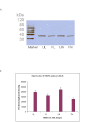Molecular characterization of novel sulfotransferases from the tick, Ixodes scapularis
- PMID: 21708020
- PMCID: PMC3150262
- DOI: 10.1186/1471-2091-12-32
Molecular characterization of novel sulfotransferases from the tick, Ixodes scapularis
Abstract
Background: Ixodes scapularis, commonly known as the blacklegged or deer tick, is the main vector of Lyme disease in the United States. Recent progress in transcriptome research has uncovered hundreds of different proteins expressed in the salivary glands of hard ticks, the majority of which have no known function, and include many novel protein families. We recently identified transcripts coding for two putative cytosolic sulfotransferases in these ticks which recognized phenolic monoamines as their substrates. In this current study, we characterize the genetic expression of these two cytosolic sulfotransferases throughout the tick life cycle as well as the enzymatic properties of the corresponding recombinant proteins. Interestingly, the resultant recombinant proteins showed sulfotransferase activity against both neurotransmitters dopamine and octopamine.
Results: The two sulfotransferase genes were coded as Ixosc SULT 1 & 2 and corresponding proteins were referred as Ixosc Sult 1 and 2. Using gene-specific primers, the sulfotransferase transcripts were detected throughout the blacklegged tick life cycle, including eggs, larvae, nymphs, adult salivary glands and adult midgut. Notably, the mRNA and protein levels were altered upon feeding during both the larval and nymphal life stages. Quantitative PCR results confirm that Ixosc SULT1 was statistically increased upon blood feeding while Ixosc SULT 2 was decreased. This altered expression led us to further characterize the function of these proteins in the Ixodid tick. The sulfotransferase genes were cloned and expressed in a bacterial expression system, and purified recombinant proteins Ixosc Sult 1(R) and 2(R) showed sulfotransferase activity against neurotransmitters dopamine and octopamine as well as the common sulfotransferase substrate p-nitrophenol. Thus, dopamine- or octopamine-sulfonation may be involved in altering the biological signal for salivary secretion in I. scapularis.
Conclusions: Collectively, these results suggest that a function of Ixosc Sult 1 and Sult 2 in Ixodid tick salivary glands may include inactivation of the salivation signal via sulfonation of dopamine or octopamine.
Figures







Similar articles
-
Lyme and Dopaminergic Function: Hypothesizing Reduced Reward Deficiency Symptomatology by Regulating Dopamine Transmission.J Syst Integr Neurosci. 2017 May;3(3):10.15761/JSIN.1000163. doi: 10.15761/JSIN.1000163. Epub 2017 May 11. J Syst Integr Neurosci. 2017. PMID: 28736624 Free PMC article.
-
Monoamine neurotransmitters as substrates for novel tick sulfotransferases, homology modeling, molecular docking, and enzyme kinetics.ACS Chem Biol. 2011 Feb 18;6(2):176-84. doi: 10.1021/cb100266g. Epub 2010 Nov 15. ACS Chem Biol. 2011. PMID: 21043483 Free PMC article.
-
Molecular characterization of neuropeptide elevenin and two elevenin receptors, IsElevR1 and IsElevR2, from the blacklegged tick, Ixodes scapularis.Insect Biochem Mol Biol. 2018 Oct;101:66-75. doi: 10.1016/j.ibmb.2018.07.005. Epub 2018 Jul 31. Insect Biochem Mol Biol. 2018. PMID: 30075240
-
The role of Ixodes scapularis, Borrelia burgdorferi and wildlife hosts in Lyme disease prevalence: A quantitative review.Ticks Tick Borne Dis. 2018 Jul;9(5):1103-1114. doi: 10.1016/j.ttbdis.2018.04.006. Epub 2018 Apr 16. Ticks Tick Borne Dis. 2018. PMID: 29680260 Review.
-
Regulation of sulfotransferase mRNA expression in male and female rats of various ages.Chem Biol Interact. 1998 Feb 20;109(1-3):299-313. doi: 10.1016/s0009-2797(97)00141-5. Chem Biol Interact. 1998. PMID: 9566754 Review.
Cited by
-
Lyme and Dopaminergic Function: Hypothesizing Reduced Reward Deficiency Symptomatology by Regulating Dopamine Transmission.J Syst Integr Neurosci. 2017 May;3(3):10.15761/JSIN.1000163. doi: 10.15761/JSIN.1000163. Epub 2017 May 11. J Syst Integr Neurosci. 2017. PMID: 28736624 Free PMC article.
-
An Insight into the Sialome of the Lone Star Tick, Amblyomma americanum, with a Glimpse on Its Time Dependent Gene Expression.PLoS One. 2015 Jul 1;10(7):e0131292. doi: 10.1371/journal.pone.0131292. eCollection 2015. PLoS One. 2015. PMID: 26131772 Free PMC article.
-
A deep insight into the sialotranscriptome of the gulf coast tick, Amblyomma maculatum.PLoS One. 2011;6(12):e28525. doi: 10.1371/journal.pone.0028525. Epub 2011 Dec 21. PLoS One. 2011. PMID: 22216098 Free PMC article.
-
Sexual differences in the sialomes of the zebra tick, Rhipicephalus pulchellus.J Proteomics. 2015 Mar 18;117:120-44. doi: 10.1016/j.jprot.2014.12.014. Epub 2015 Jan 7. J Proteomics. 2015. PMID: 25576852 Free PMC article.
-
Insight Into the Dynamics of the Ixodes ricinus Nymphal Midgut Proteome.Mol Cell Proteomics. 2023 Nov;22(11):100663. doi: 10.1016/j.mcpro.2023.100663. Epub 2023 Oct 12. Mol Cell Proteomics. 2023. PMID: 37832788 Free PMC article.
References
-
- Balashov YS. Bloodsucking ticks (Ixodoidea), vectors of disease of man and animals. Miscellaneous Publications of the Entomological Society of America. 1972;8:163–376.
-
- Sonenshine D. Biology of ticks. Vol. 2. Oxford University Press, New York; 1993.
Publication types
MeSH terms
Substances
Grants and funding
LinkOut - more resources
Full Text Sources

